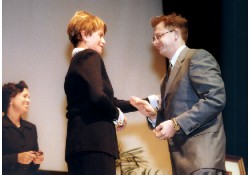
Dean Colleen Conway-Welch, Ph.D., congratulated student Stephen Miller at the Nursing School's pinning ceremony.
(photo by Donna Jones Bailey)
Challenges await incoming Nursing School students
When Colleen Conway-Welch, Ph.D., Dean of the School of Nursing and Professor of Nursing welcomed the 1999 nursing students last week, she was quick to offer the class a to do list: take a deep breath, pace yourself, narrow your projects and ask for help.
The advice was well received. Sighs of relief and smiles were quick signs that the 243 new students enrolled in the school this fall anticipated a challenging year.
"Pain and change are givens," Conway-Welch said. "But suffering is optional. This experience will change your life. When you finish, you'll be totally different.
"Nursing is anything you want it to be. A nursing license gives you an enormous amount of opportunities. It is flexible and exciting. The possibilities are endless."
Although starting a new school year is always exciting, this year is especially noteworthy because Frist Hall is complete. The 25,000-square-foot building, named for Patricia Champion Frist, wife of Dr. Thomas Frist, Jr., includes a new student lounge, an 80-seat, multi-media classroom; two multi-purpose rooms and a 30-seat classroom. The building also includes 35 faculty offices, workspaces and three conference rooms.
"This is the first year we have been able to welcome the students without construction," Conway-Welch said. "It is also wonderful to see the variety of multiple-entry students as well as the increase in minority enrollment. We are happy to see those numbers jump."
The total number of students in this year's class of 243 is a 9 percent increase over the 1998 enrollment with students studying in 12 different nursing specialties. There is one new course offered this fall, an adult nurse practitioner with a focus on correctional health.
The breakdown of the class includes 12 percent male; 12 percent minority; 50 percent from Tennessee; 13 percent from the mid-south region and 34 states are represented.













